October 30th, 2006
Jason Dunn
“While at Mobius, Jenneth and I were both presented with a set of Ultimate Ears super.fi 5 Pro Earphones. It seemed redundant to write separate reviews about the same product, so we decided to combine forces and write a dually to post on both our sites - we’re trying something new! For reference: My remarks will be in the regular page colors, and Jenneth’s will be in blue and italicized.** Just because you have the finest digital music player that money can buy doesn’t mean that it will sound all that better if you are still using the basic earbuds it shipped with. That’s assuming you can even get the OEM earbuds to stay in your ear!”
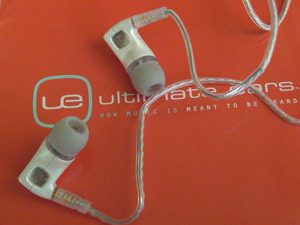
I figured that since I just posted my own review of these headphones, it would be worthwhile to link to another opinion on them - Gear Diary has a cool two-person review that has a lot of photographs and details that my review didn’t have. Check it out!
October 26th, 2006
Jason Dunn
“Over the last year I have grown incredibly spoiled when I travel because I no longer need to pack a tangle of “spaghetti”; instead, I bring along a set of Gomadic Charging Cables. The same single cable charges my PDA, mobile phone and digital music player. It can charge Steve’s phone, Sarah’s phone, and Sarah’s digital music player, too; all it takes is the proper tip for each particular device. For those unfamiliar with Gomadic, I’ll state the premise in a nutshell: They sell cables with plugs on their ends which will accept their specially made tips; these tips fit many of today’s popular consumer mobile devices. Gomadic’s “Tip Exchange Technology” means that the same cable can be used for years - and as devices are added to the user’s collection, new tips can be purchased to swap out with the old.”
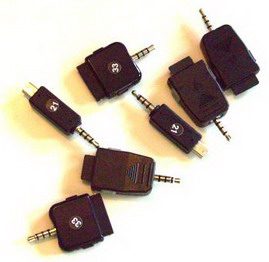
We all deal with battery life issues (check out my review of this big laptop battery) with our Windows Mobile devices, and coming up with a system to always keep things charged up and ready to go can be challenging. USB-based sync and charge cables help greatly, but what if you have devices that all require different heads? This system that Judie reviewed looks like it solves that problem - I’ll have to look into it more carefully…in the meantime, check out Judie’s excellent review!
October 23rd, 2006
Jason Dunn
Headphones are one of the most important parts of any music listening experience – together with the audio player itself and the quality of the encoded music – but most digital audio players come with extremely cheap headphones. Perhaps it’s because the manufacturers know the first thing many people do is discard included headphones, and thus they don’t want to invest any significant money in the bundled headphones. Or, perhaps it’s because quality headphones cost money (which would raise the cost of the overall product), and a good portion of the public doesn’t know how good music can really sound with great headphones. Regardless of the reason why bundled headphones are usually of poor quality, if you’re still using the standard headphones that came with your Windows Mobile Pocket PC or Smartphone, your music isn’t sounding as good as it should.
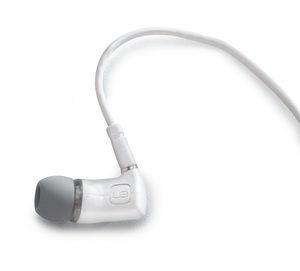
The Ultimate Ears super.fi 3 Studio headphones
In my search for headphones to review, I came across Ultimate Ears – they’re a company that has historically made custom stage performance headphones for professional musicians, and have recently taken that core technology and brought it down-stream to a line of consumer products. With the likes of Metallica and Third Day (check out the complete list) using their professional products, it boded well for the quality of their consumer products, so I was looking forward to checking out what they had to offer. I had initially wanted to look at the Creative Zen Aurvana headphones, but repeated requests for a pair were declined or ignored, so I looked elsewhere. Am I ever glad I did!
I tested three sets of headphones, running the gamut from free to quite expensive: a pair of headphones that came bundled with a Sandisk MP3 player (which are actually slightly better than most bundled headphones I’ve used, but adequately represent the headphones that usually come with Windows Mobile Pocket PCs and Smartphones), a pair of Ultimate Ears super.fi 3 Studio headphones ($99 USD MSRP), and a pair of super.fi 5 Pro headphones ($249 USD MSRP). All three were tested using a Windows Mobile 5-based iPAQ 1950 Pocket PC, using 256 kbps MP3 files. The iPAQ’s system volume level is a six-level slider, and I had it set on the fourth-loudest level. The volume setting inside Windows Media Player 10 Mobile, the application I used for the tests, was set to 80%. This is a reasonable middle-ground volume level, though I did crank up the headphones to the point of causing myself pain – the Ultimate Ears headphones are loud! To round out the testing I also listened using my laptop and a Creative Zen Vision:M audio player.
For testing purposes, I decided to focus on a common real-world scenario: use while traveling. It’s easy to test headphones in a quiet room, but most people use headphones while mobile – working out in a gym, traveling on a plane, or sitting on a bus. I decided to do my tests in a car where I was a passenger on a five hour highway trip. The driver and another passenger were conversing most of the way, and listening to music on the car stereo, so between that and highway road noise in a Mini Cooper, it seemed like a difficult situation for headphones to shine. In terms of what songs I used, I selected a cross-section of music (I listened to many more songs than these using the super.fi headphones, from a variety of genres and styles, but these were the four songs I focused on the most using the iPAQ 1950):
- Stevie Wonder, Superstition – this classic song was recorded in the 1970’s, and the drums, bass, and guitar all have a very smooth, natural sound.
- Plumb, Boys Don’t Cry – a modern pop track with an ethereal keyboard intro, soft female vocals, and a layered arrangement that explodes into a high energy chorus with electric guitars at the end.
- The Beatles, Lovely Rita – it doesn’t get more classic pop that the Beatles, and this 1960’s song has lush vocals, an energetic bass line, crisp piano, and copious amounts of subtle background noises from the old-school recording process.
- Click Five, Just The Girl – a song typical of current pop, the volume and energy level of this track are typical for three-chord rock (and the recording is loud). Crunchy electric guitar, thumping bass, pounding drums, and tight multipart vocal harmonies make this a good representation of modern recordings.
Testing headphones is even harder than testing audio speakers, because not only do you have the inherent personal bias of what subjectively sounds good or not, but you also have only one pair of ears: there’s no way to instantly switch from one pair of headphones to another, as you can do with speakers, to hear how each set handles a part of a certain song. Instead, you have to listen to a part of a song, switch headphones, and then try to remember how it sounded with the first pair of headphones. It sounds easier than it is – especially when the differences are slight. I’ve been using the superfi.3 headphones for almost a month now, so I had a good feeling for how good they were with a variety of music, but with the sample songs I focused on how each pair of headphones impacted the overall experience of listening to the music.
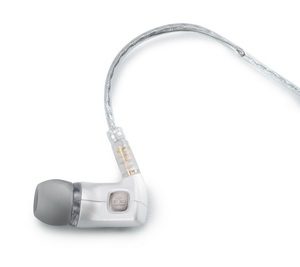
The Ultimate Ears super.fi 5 Pro headphones
So how did the super.fi headphones actually sound? In a word: amazing. Strong bass response, crisp high-end, and luscious mid-range. Every song I listened to sounded superb. Not surprisingly, the “freebie” headphones sounded horrible in comparison. One of the biggest issues was that although they were in-ear headphones, they were not designed to create a seal in the ear canal. Because of that, the sound going into my ear drum was equal part music and external noise. To combat this, most people crank up the volume, which ends up making the music muddy-sounding as many headphones can’t handle high volume (nor can most ear drums for that matter). It also has the side effect of irritating everyone around them. The Ultimate Ears products, on the other hand, let you hear nothing but the music, so you can listen at a lower volume – and the super.fi’s present subtle elements in the song that you probably haven’t heard before. If you normally listen to music using desktop computer speakers, you might be quite surprised at how different your music sounds when heard through the super.fi headphones.
The two models of super.fi headphones are virtually identical in design – both are over-the-ear, in-ear headphones. That means that they are placed in your ear canal, and rely on blocking the canal to reduce outside noise. To this end, the supfer.fi headphones include four different sizes of soft rubber plugs, and one pair of soft form plugs. The ideal pair is the one that feels the best, but also fills the ear canal completely and creates a light suction feeling. This makes them “noise reduction” headphones, rather than the more effective (but battery-powered) active noise-cancellation headphones that use microphones and white noise to block external noise. On planes and in cars, I found the noise blocking abilities of the super.fi headphones to be quite effective - I’d say they block about 80% of the outside noise.
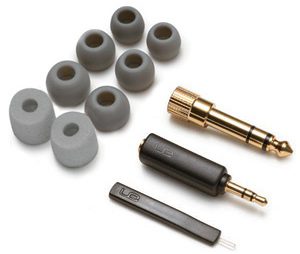
The super.fi 5’s accessories - mine came with an extra ear insert not shown.
Putting on the super.fi headphones takes a bit of practice – they have to be inserted then twisted backward and toward you to create the suction necessary for proper sound. The stiff wire coming out of each headphone is then bent down over the back of the ear to secure the headphone in place. The first few times I put them in, I found the process awkward, but now it’s quick and easy for me. Ultimate Ears has a short demonstration video that shows you how to install them properly. Both super.fi headphones come with a small metal carrying case, the aforementioned rubber plugs, and a small tool to clean the ear wax off the plugs. The super.fi 5’s also include a 1/4″ jack (useful for musicians who want to use them as audio monitors).
One thing I wish was different was the metal carrying case – it’s just an empty container, there’s no spooling mechanism for storage, so you end up just cramming the headphones in and trying to get the lid shut. Not ideal, and certainly not impressive in the case of the expensive supfer.fi 5’s. There’s an optional winding spool for the carrying case that’s sold seperately, but it should be standard on headphones this expensive (both pairs). I also found the cable to be a bit too stiff - it’s a bit frustrating to have a cable going in random directions instead of just lying down flat.

See how the cable doesn’t lay flat? A bit irritating.
The real question isn’t whether the Ultimate Ears super.fi headphones are worthy of replacing the bundled headphones you got with your device – they absolutely are. But which pair of super.fi headphones represents the best value? There’s a big price difference between $99 and $249, and I believe that the supfer.fi 3’s (the $99 pair) are in the sweet spot between price and quality. The super.fi 3’s are light years better than any bundled headphones, but the $249 super.fi 5’s don’t sound good enough to justify the difference in price with most music. The exception here would be if you happen to listen to music where subtlety and nuance are important – say, jazz or classical. I found that the super.fi 5’s allowed me to hear things that I missed with the super.fi 3’s – on the Stevie Wonder track, I heard a slight recording hiss, could hear the cymbals on the drums more clearly, and the kick drum had more presence. On another song, Creed’s Pity for a Dime, I could hear the sound of a guitar pick scraping the guitar strings before the guitar player strummed. That’s impressive sonic detail. In almost every other way, however, when I switched between the super.fi 3’s and the super.fi 5’s, I had a hard time telling the difference between the two. The basic elements of the song were delivered with equal amounts of power and punch by both sets of headphones.
The bottom line is that either Ultimate Ears product will dramatically enhance the quality of your music experience with your Windows Mobile device. I can highly recommend either product, and if I had an “Editors Choice Award” here at the Two Inch View, both supfer.fi products would win one.
October 17th, 2006
Jason Dunn

There’s a new media player in town, and it’s called the CorePlayer for Windows Mobile. If that name sounds familiar, it’s because the CorePlayer is the new name for TCPMP, an application that I’ve talked about here before. It maintains the broad codec support, offering AAC, MP3, WMA, WMV9, DIVX, XVID, MP4, MKV and MIDI file playback. What’s a bit surprising though is the price - it’s gone from being free to costing $24.99 USD. For a media player, that’s fairly expensive. There’s also a bug with the first release where the options menu was disabled by the developer. So here’s what I suggest if you’re interested in this application: go to this Pocket PC Thoughts thread to grab the $5 discount code, buy the app, then wait a day or two for the developer to release a version with a working options menu.






